
Guest blog by Anna Sheppard Head of PE, The Alice Smith School
To put curriculum design into a blog or presentation is quite a task. Curriculum design is vast and I would say it is never complete. It is ongoing and evolves to meet the needs of your students and the ever changing context that you are in.
Your People
Curriculum design is a team effort and to work with others takes both time and trust. When undergoing any form of change it is important to understand who is with you. I often refer to the bus.
Who is on your PE bus?
Who is driving your bus? Is it you? Where is the bus going?
Where are your team sitting on your bus, right behind the driver or at the back of the bus enjoying the ride?
In the international context, there are often those with early intentions of moving on at the end of the academic year.
Who is waiting at the bus stop ready to support you in the future journey?
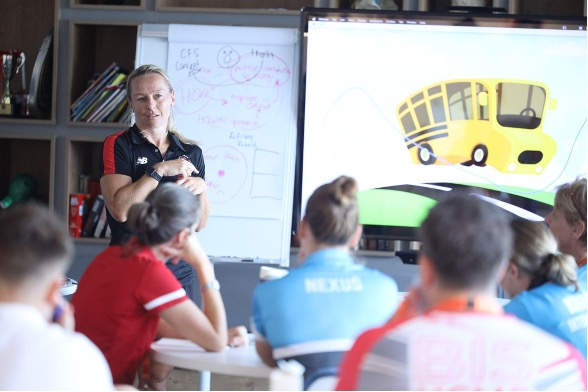
You have a team, but do you really know how your team feels about PE?
Many PE teachers questioned their purpose during Covid-19 and used this time as an opportunity to reflect. Some were brave enough to publicly question and share their ‘why’, like Lee Sullivan through his publication Is PE in crisis? Some schools and colleagues came out of this period with real clarity as to the direction of PE, whilst other colleagues disagreed with the changing environment.
Where do you and your colleagues sit?
Do they see PE as a skill based subject that feeds into a competitive sports programme?
Or do your colleagues view PE differently?
Are you teaching concepts such as resilience or marginal gains?
A simple task to explore how they view PE that we did in our department and which I repeated with PE colleagues recently at a conference in Singapore is as follows:
Team Task
On a post it note write down ‘what PE is’ and ‘what PE is not’
Very quickly you will gauge the views of your team.
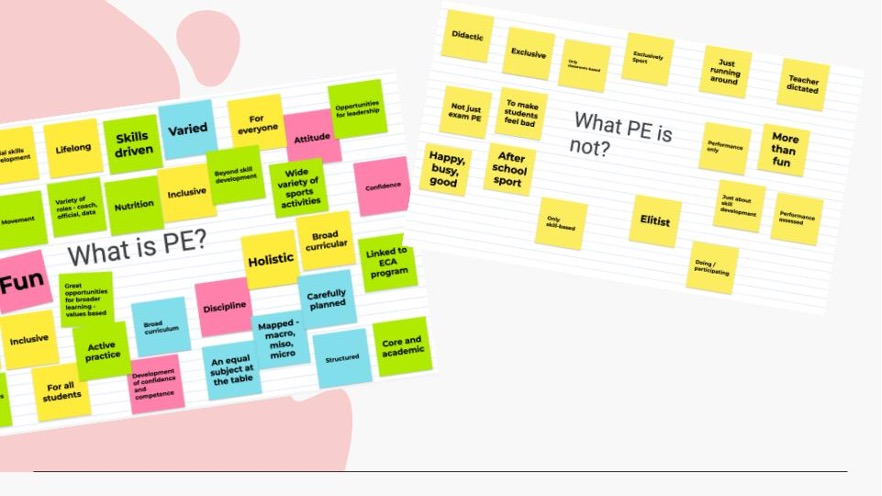
In the international school context, teams can change quickly and it is important to understand individual strengths within the team and who is on board with the prospect of change.
Have one eye on the Kubler-Ross change curve.
Do you know where your colleagues are on the curve?
Are they at shock and denial or well on their way to acceptance?
Your Students
The ‘Who?’
In keeping with the bus theme, I would describe school curriculum design as a journey. Most journeys start at the beginning, whereas in education it is necessary to start with the end. Backwards by design is starting with the end in mind (Mccrea, 2015). Many begin their journey with the ‘Why’ or the purpose; however, I’m inclined to agree with Michael Bachmann (2018) and many others (Swaithes & Durden Myers, 2021 for AISEP, @ImSporticus, 2021, Dryer, 2022) who suggest we need to begin with the ‘Who’.
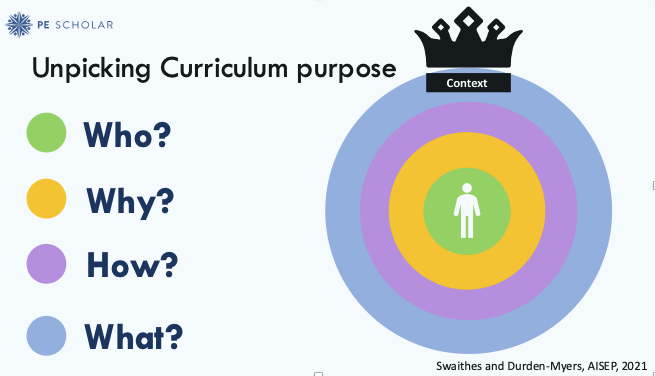
In our department we started with, ‘What do we want an Alice Smith School alumni to have gained from PE if we were to see them in 5, 10, or 20 year’s time?’
We considered their attitudes, their skills, their knowledge and their experiences. We were unanimous that we wanted them to still be physically active many years on.
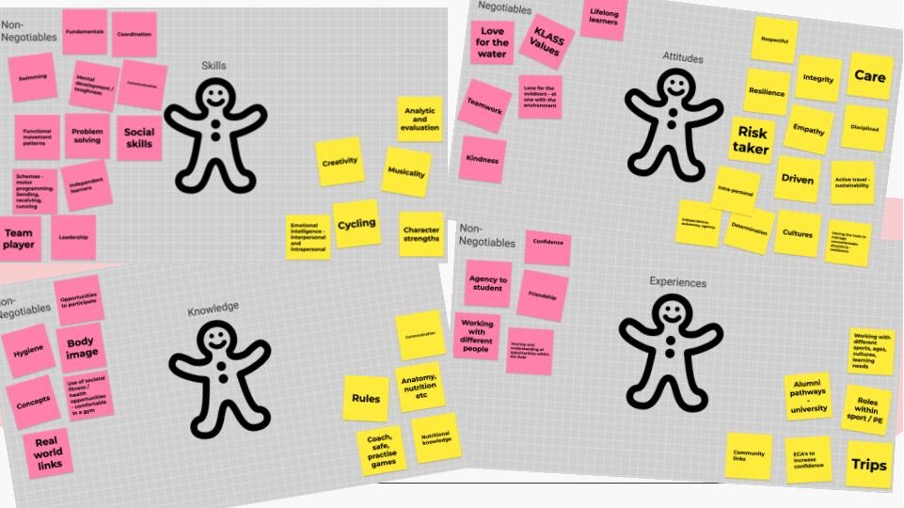
The gingerbread person activity is useful. Phil Mathe describes a similar approach in his excellent publication, Happiness Factories, and this is one of the early tasks completed on PE Scholar’s PE Curriculum Design Programme that has supported hundreds of curriculum leaders since 2021.
Student voice
Student voice can be invaluable when looking at curriculum design. Student voice is not just asking students what their favourite activities are and putting together a list of the popular sports such as football, netball and badminton. It’s about understanding a student’s connection to physical activity. The gingerbread person activity works equally well with young people.
…’The physically educated person isn’t just an individual with an accumulation of domain specific knowledge and skills, but is also a person who values forms of movement and sees a place for it in their life…’ (Sporticus, 2022)
What do our children want and need for the future?
What can we learn and experience during our PE curriculum that will support them in a changing world?
What do they find relevant, significant and challenging?
How do you know?
Your Purpose
The ‘Why?’
What’s your purpose?
What is your department’s purpose?
What’s your school’s purpose?
I have been very clear from the outset that my purpose is to support young people in being physically active for life. Inclusion is core to my philosophy.
As a department we developed the new PE purpose and spent time considering what physical literacy means to us and to our students.
Physical literacy
The purpose of our PE Curriculum is to nurture and develop student physical literacy.
‘Physical literacy is the motivation, confidence, physical competence, knowledge and understanding to value and take responsibility for engagement in physical activities for life.’ (IPLA, 2017)
As a school we have a new purpose and the opportunity to spark courageous exploration to inspire a better world. With this curriculum intent, there is the flexibility for PE to expand beyond the traditional sports skill offering and national curriculum aims.
With support from the PE Scholar Curriculum Design Course, I looked into the research around physical literacy and considered all the elements required in creating a PE curriculum that meets the needs of our context and the holistic development of our students. We considered the four parts of physical literacy and looked at how this could underpin our assessment moving forward.
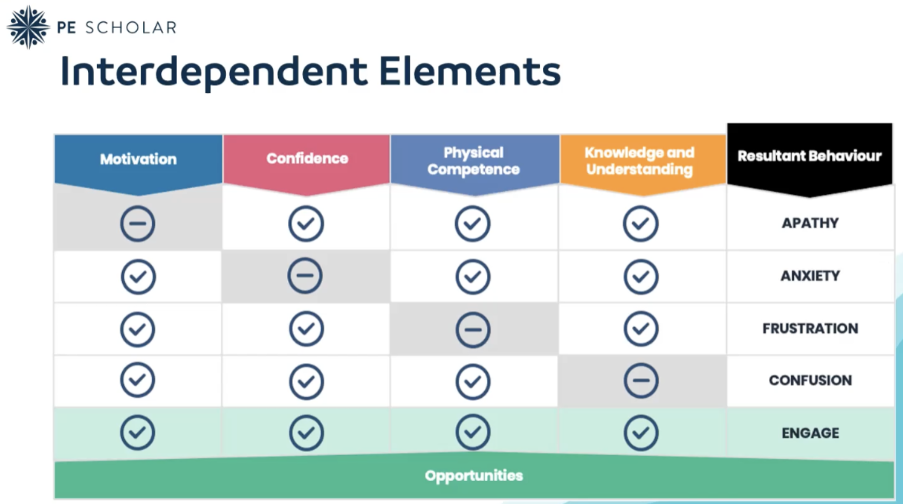
Research-informed choices
A synthesis of up-to-date research around physical activity, girls in sport, personality types and mental health provided by PE Scholar helped to shape our direction and inform the ‘How.’ At a recent conference I presented curriculum design to delegates from the Asia region and shared the following considerations:
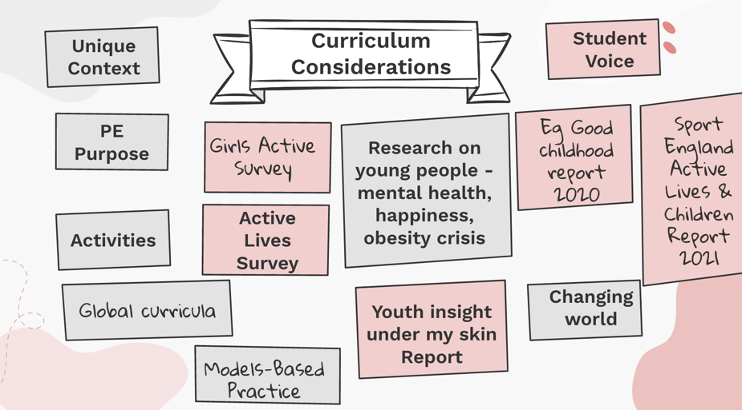
Assessment
There are many blogs and written pieces on assessment in PE and it continues to be a major discussion topic between colleagues.
As a department group we explored and specifically looked at examples from Andrew Frapwell’s Head, Heart, Hands and Tom Brush’s interpretation of Matt Bowlers Me in PE assessment models. However, we wanted an assessment that suited our students and our context.
As a department team we designated meetings to the discussion and development of our own assessment criteria and developed the following:

We feel this assessment aligns with our purpose, to nurture and develop physical literacyand importantly the holistic development of the whole child.
Your Delivery
The ‘How?’
This is where many schools have started with their planning. PE teachers selecting activities based on school sport seasons and the expertise of the PE staff.
I’m not suggesting that these are not considerations. There are many considerations. For many schools there are logistical challenges like multiple PE classes at the same time in limited spaces which requires careful planning and often a carousel of units across the year. The weather is a factor, losing facilities for exams is another factor. International schools don’t escape this and we have the consideration of rain and extreme heat as well as transient communities.
We are lucky that we don’t have restrictions with facilities at the Alice Smith School. We have a plethora of indoor and outdoor facilities and even a 50m by 25m swimming pool. We have the opportunity to be creative and innovative with our units and consequently are able to offer full units of work in activities such as stand up paddle boarding!
The student journey
However, it should not be about individual activities and units of work, there should be scope and sequence. We have spent much time mapping out the journey which has considered the breadth and depth of activities. I am inclined to agree with Beckey’s dislike for a broad and balanced curriculum and have considered the relevance and significance of units.
Our role is for all children in our care to thrive. It is therefore imperative that our journey encompasses where we began; what do we want our Alice Smith alumni to have gained from their PE experiences (the gingerbread person activity). Across our unit, our term, our year, our school journey are we learning, unlearning and relearning the important skills and knowledge? Are we having the opportunity to develop the attitudes and values necessary for the future?
Models based practice
‘The ‘What?’
Using our knowledge of models based practice, concept mapping and all the considerations mentioned already, we have developed our student journey. We use TGFU where it adds value, we teach units and pe lessons through the Game Sense model where there is benefit and use sport education to develop leadership and interest. We are not dictated by activities and use key concepts to make connections to real world situations.

Summary
The PE curriculum at the Alice Smith School will never be complete and will continue to evolve. Curriculum will always benefit from refinement. However, there is clarity for our students and clear pathway mapped. Our focus is holistic, our concepts develop the thinker, and we have attempted to ensure relevance, significance and challenge for each and every learner.
In part 2 of this blog I will share our concept journey and our concept framework for each unit of work.
References
Beckey, A (2022) Start with who
Beckey, A (2022) Rethinking a ‘broad and balanced curriculum’
Dryer, G (2022) Student voice in PE (and why Sinek is wrong)
Griffin, B (2021) Key Stage 3 PE: Choosing An Assessment Model That Helps Pupils Thrive
Malik, P (2021) The Kübler Ross Change Curve in the Workplace (2023)
Mathe, P (2021) Happiness Factories
Mccrea, P (2015) The 7 habits of highly effective lesson plans
Sullivan, L (2021) Is PE in Crisis?
Guest blogger: Anna Sheppard is Head of PE at Alice Smith School in Kuala Lumpar and also Chair of FOBISIA PE & Sport, a network of schools PE Scholar have enjoyed collaborating with for some time now.
Further curriculum ideas and resources
At PE Scholar we aim to provide high-quality materials and expert knowledge to make your teaching that bit easier. Below are some further resources and insights to support you with your PE curriculum.
The Primary Concept Curriculum insight
Concept curriculum lesson templates
Concept curriculum non-performer worksheet
Lesson walkthroughs: Early Years, Year One, Year Two, Year Three, Year Four, Year Five and Year Six
Mapping your PE Curriculum resource
Conceptual PE: a course for the future research publication
Purchase the Concept Curriculum – Primary and Secondary


[…] PE curriculum design guest blog […]
[…] PE curriculum design guest blog […]
[…] PE curriculum design guest blog […]